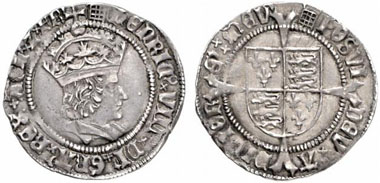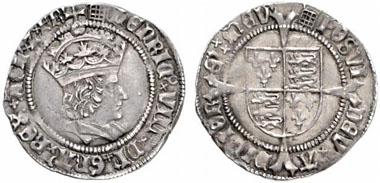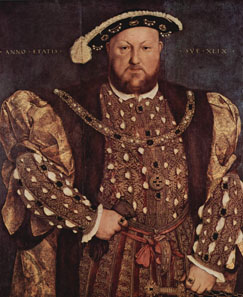Henry VIII – the Man Who Had Six Wives
by Björn Schöpe
courtesy of Barbara Balz / World Money Fair
On this coin, Henry VIII had himself portrayed in the manner of an Italian Renaissance prince: Long curly hair, an effigy with realistic features as it had not been seen before on coins. With his accession to the throne in 1509, a new era had begun. The young king was popular and people put hope in him. Henry was an ambitious athlete, well-educated and tall – and he definitely became the nation’s darling when he forgave all debtors of his late father.
Henry VIII (1509-1547). Groat, London, no year (1509-1526). Seaby 2316. From Künker auction 119 (2007), 799.
His youth, however, had left a mark on the king. The experience of wars, arisen from unclear lines of succession, had made him cautious. First of all, he needed a male heir. His father had secured a Papal dispensation to allow Henry to marry Catherine of Aragon, the widow of his brother. But after giving birth to a daughter, Catherine’s following children were stillborn or died as infants. Although badly wanted, there was no male offspring – for which Henry found an explanation: With this marriage, he had offended against God’s own law.
For political reasons, Henry’s efforts to achieve an annulment of the marriage remained fruitless. For two years, his mistress Anne Boleyn appeared at his side like the new queen. Then, she put him under pressure – marriage or nothing at all. The king could not resist any longer and had the Archbishop of Canterbury seal the union with the blessing of the church. As expected, everybody involved was excommunicated by the Pope, but Henry was willing to accept the consequences for his country. Shortly afterwards, a child was born – a girl. It did not take long until the mother was executed under the pretext of adultery.
Portrait of Henry VIII, c. 1539-1540 by Hans Holbein the Younger (1498-1543). Source: Wikipedia.
Unlike former rulers who had been banished by Rome, Henry did not seek reconciliation with the Church. He probably anticipated that his matrimonial policy would sabotage any agreement. As a consequence, he founded the Church of England – for convenience, with himself at the head. Thus, the English king united the secular and clerical power in his territory, like all his successors until the present day.
His next wife finally gave birth to a son, but died in childbed. Another candidate for marriage was brought from Germany; the famous Hans Holbein had sent a promising portrait of her in advance. Probably, it flattered her; in reality, however, Anne of Cleve belied Henry’s expectations. And she was not to be the last consort … In Britain, a mnemonic is used to remember the six marriages in correct order, “Divorced, beheaded, died; divorced, beheaded, survived.”
This article was written for the catalogue of the World Money Fair 2012 whose Guest of Honour is going to be Great Britain. More on the World Money Fair 2012 you can read here.







